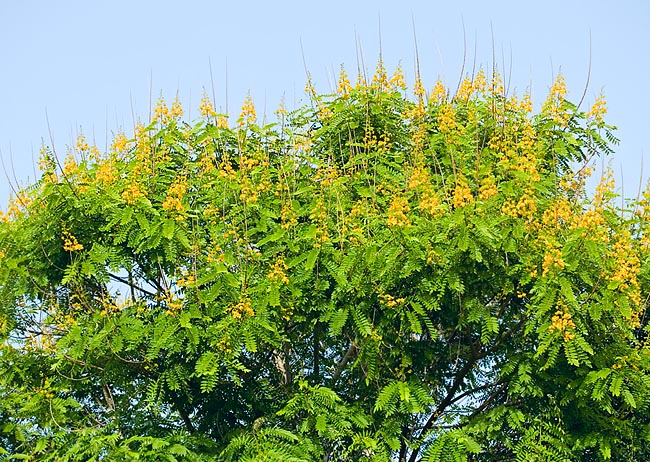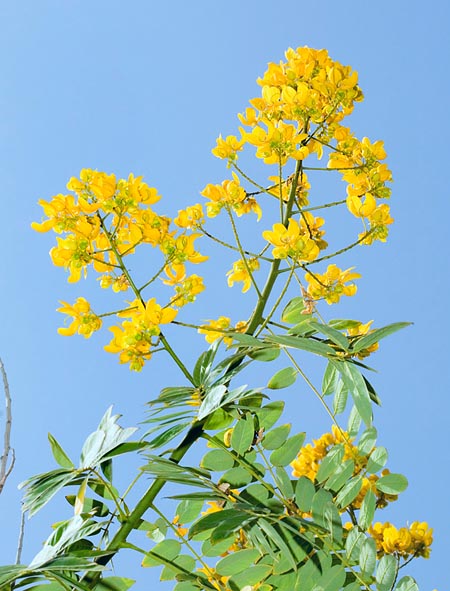Family : Fabaceae

Text © Pietro Puccio

English translation by Mario Beltramini

Senna spectabilis is an expanded foliage tropical small tree and may be more than 10 m tall © Giuseppe Mazza
The name of the genus comes from the Arabic “sanā” with which was called the Senna alexandrina Mill.; the name of the species is the Latin word “spectabilis” = considerable, with reference to its ornamental characteristics.
Common names: golden wonder, yellow cassia (English); acássia, canafístula-de-besouro, cássia do nordeste, pau-de-ovelha, tula-de-besouro (Portuguese – Brazil); algarrobilo, candelillo, carnaval, casia amarilla, casse marron, chiquichique, chucaro, flor de todos los santos, frijolillo, mucutena, velero, velillo (Spanish); mhomba (Swahili).
The Senna spectabilis (DC.) H. S. Irwin & Barneby (1982) is a shrub or a deciduous tree with a wide crown, fast growing, 4-10 m tall; even if in the wild old specimens may reach 18 m, with diameter of the trunk up to about 30 cm and a grey bark tending to redden with the age. The leaves are alternate, rather pendulous, 20-35 cm long, pinnate, with 7-15 pairs of ovate to lanceolate leaflets with entire margins, 3-8 cm long and 1-2 cm broad, with sharp apex, of an intense green colour, pubescent below.

The inflorescences are thick 10-50 cm racemes with 3,5-4 cm corollas © Mazza
It is a widely cultivated species in the tropical and subtropical climate zones as ornamental plant, due to its delicate foliage and the showy late-summer blooming, and also as shade tree. It is not particular for what the ground is concerned, even if in the fertile, deep and well drained it can grow with particular vigour; it does not stand temperatures just below 0 °C, if not exceptional and of very short duration. The watering must be regular in summer, but allowing the first layers of the soil to dry up; well rooted plants may bear dry periods. The containment and shaping pruning are quite useful after the flowering.
The leaves have a high contents of nitrogen (3,3%) and the plant can produce a huge quantity of biomass rich of it; for such purpose it was rightly planted at the borders of the cultivated fields, but this nitrogen was detrimental to that contained in the ground, as a matter of fact, this species does not fix symbiotically the nitrogen of the air, like other leguminous plants which are therefore to be preferred. The wood is utilized locally as combustible, for building fences and for realizing small appliances. Being a melliferous plant, it is often cultivated for this purpose. Finally, extracts of the plant are used in the traditional medicine as analgesic, anti-inflammatory, laxative and purgative.
Synonyms: Cassia spectabilis DC. (1813); Cassia speciosa Kunth (1824); Cassia humboldtiana DC. (1825); Cathartocarpus humboldtianus Loudon (1830); Cathartocarpus speciosus (DC.) G.Don (1832); Cathartocarpus trinitatis (DC.) G.Don (1832); Cassia trinitatis Benth. (1840); Cassia edulis Posado in Baill. (1872); Cassia edulis Posada-Ar. (1872); Cassia edulis Sessé & Moc. (1888); Cassia totonaca Sesse & Moc. (1894); Cassia carnaval Speg. (1910); Cassia amazonica Ducke (1922); Pseudocassia spectabilis (DC.) Britton & Rose (1930).
→ To appreciate the biodiversity within the family of FABACEAE please click here.
